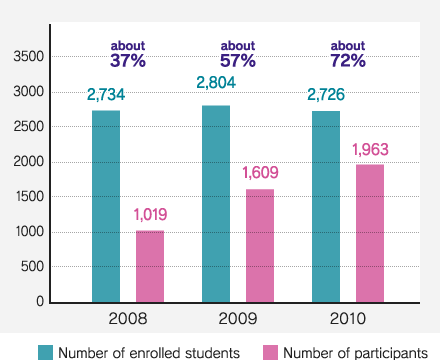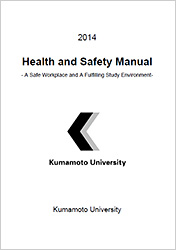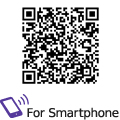Safety
Education
Safety Guidelines (General Edition)
The "Safety Guidelines (General Edition)" was separated from the "Health
and Safety Guide" in 2018 as part of a review of health and safety
education at the university. From now on, it will be edited by the
Environmental Safety Center. In addition, although the booklet has been
distributed to new students and new hires in book form, it has also been
available online since 2018.
The Crisis Management and Health sections of the Health and Safety Guide
have been moved to the following sites.
Safety education (e-learning)
Environmental Safety Center has created the following e-learning courses as
safety education.
If you are not registered and would like to take the course, please contact
Environmental Safety Center.
- General education course for new
students(【7】Environmentally Conscious Activities You Can Do、【8】
Risks around your life )(Japanese only)
Target: New undergraduate students - Safety to obtain peace of mind(Japanese only)
Target: New undergraduate students - Health to obtain peace of mind(Japanese only)
Target: New undergraduate students
Click here for chemical safety education
New Student STARTUP Lecture: Risks Around Our Lives
 The "New Student STARTUP Lecture" is a training program sponsored by the
Headquarters for Admissions and Education that started in 2017. It is designed
to help students lead a fulfilling university life.
The "New Student STARTUP Lecture" is a training program sponsored by the
Headquarters for Admissions and Education that started in 2017. It is designed
to help students lead a fulfilling university life.
Target audience: New undergraduate students
"Risks Around Our Lives" is part of the "New Student STARTUP Lecture" taught by
the Environmental Safety Center. It will be offered online, so students can take
the course "anytime, anywhere".
Course method: Online learning (please use Kumamoto University Moodle)
Course deadline: Up to 3rd-year students
< Course content> To live in peace, it is necessary to prevent accidents and
crimes (safety management and crime prevention) and minimize damage in the
event of a disaster (disaster prevention and disaster mitigation). This
section focuses on safety management methods that prevent accidents in daily
life, learning about risks, thinking about risk reduction measures, and
putting it all into practice ourselves.
(End) Health and Safety Guide
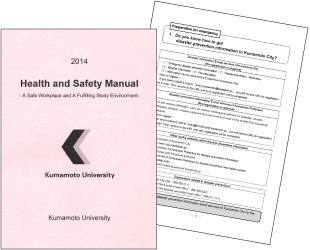 The
Health and Safety Guide was edited by an editorial committee established in the
Safety Management Committee of Kumamoto University in 1994 and published as the
"Safety Guide" in 1995. Since its incorporation in 2004, the current "The Health
and Safety Guide" was jointly edited by the Environmental Safety Center and the
Central Safety and Health Committee in 2005. Since 2012, the Health Care Center
has also joined the editing process.
The
Health and Safety Guide was edited by an editorial committee established in the
Safety Management Committee of Kumamoto University in 1994 and published as the
"Safety Guide" in 1995. Since its incorporation in 2004, the current "The Health
and Safety Guide" was jointly edited by the Environmental Safety Center and the
Central Safety and Health Committee in 2005. Since 2012, the Health Care Center
has also joined the editing process.
The "Health and Safety Guide" was distributed to new students and newly hired
staff until 2017. The content was about health and safety to the extent that
both science and humanities students could understand it.
Since 2018, health and safety training has been reviewed and edited as a "Safety
Manual (General)" and has been available online.
(End) Basic Common Core Courses "Risks Around Our Lives"
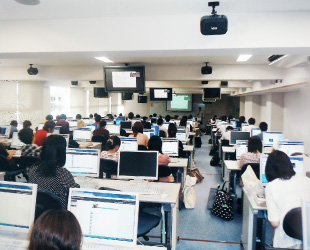 Basic Common Core Courses were offered in Liberal Arts Education from 2011 to
2016. It was provided as a transition to higher education or as
First-Year-Experience (FYE) in higher education.
Basic Common Core Courses were offered in Liberal Arts Education from 2011 to
2016. It was provided as a transition to higher education or as
First-Year-Experience (FYE) in higher education.
Target audience: New undergraduate students (1 credit required, elective for
Faculty of Education and Faculty of Science)
"Risks around Our Lives" was the "basic" part of the course taught by the
Environmental Safety Center. Twenty minutes of the topic were delivered
face-to-face, and students experienced the rest via online learning.
< Objectives>
By paying attention to safety in university life, students can reduce the
probability of accidents and can respond appropriately if disasters occur.
Particularly in science departments, this can contribute to elementary
safety checks related to specialized technologies.
Learning Resources
Chapter 1: A Case Study of an Accident Caused by a University Student
Chapter 2: A Case study of a disaster in Kumamoto
Chapter 3: Safety
Chapter 4: Identifying Risks
Chapter 5: Risk reduction methods
Chapter 6: Initial activities when a disaster occurs
Web Assignment
1. Introduce an interesting case from the "Hiyari Hatto (close call) Case
Studies" of the Safety Information Center.
2. Please introduce a recent "Hiyari-Hatto" case that you have experienced.
3. What is the most dangerous event you have experienced?
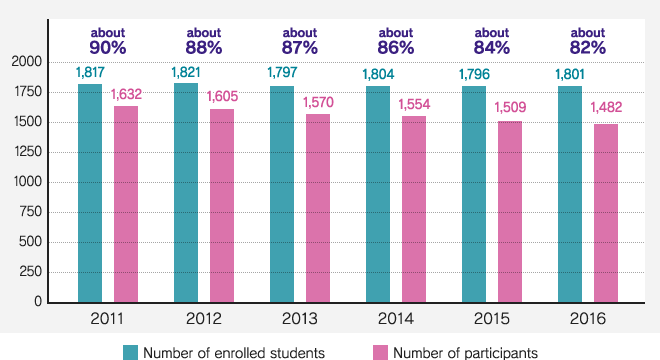
(End) Lecture on environmental safety
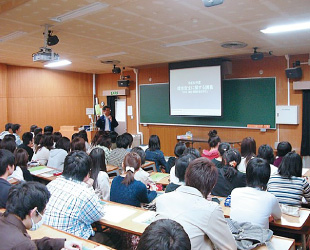 Lectures on environmental safety were offered as part of the 60-minute guidance
sessions in each faculty, department, and graduate school/major from 2008 to
2010.
Lectures on environmental safety were offered as part of the 60-minute guidance
sessions in each faculty, department, and graduate school/major from 2008 to
2010.
Target audience: New undergraduate and graduate students
Lectures on environmental safety were given by the Environmental Safety Center.
The textbook "Health and Safety Guide" was used.
